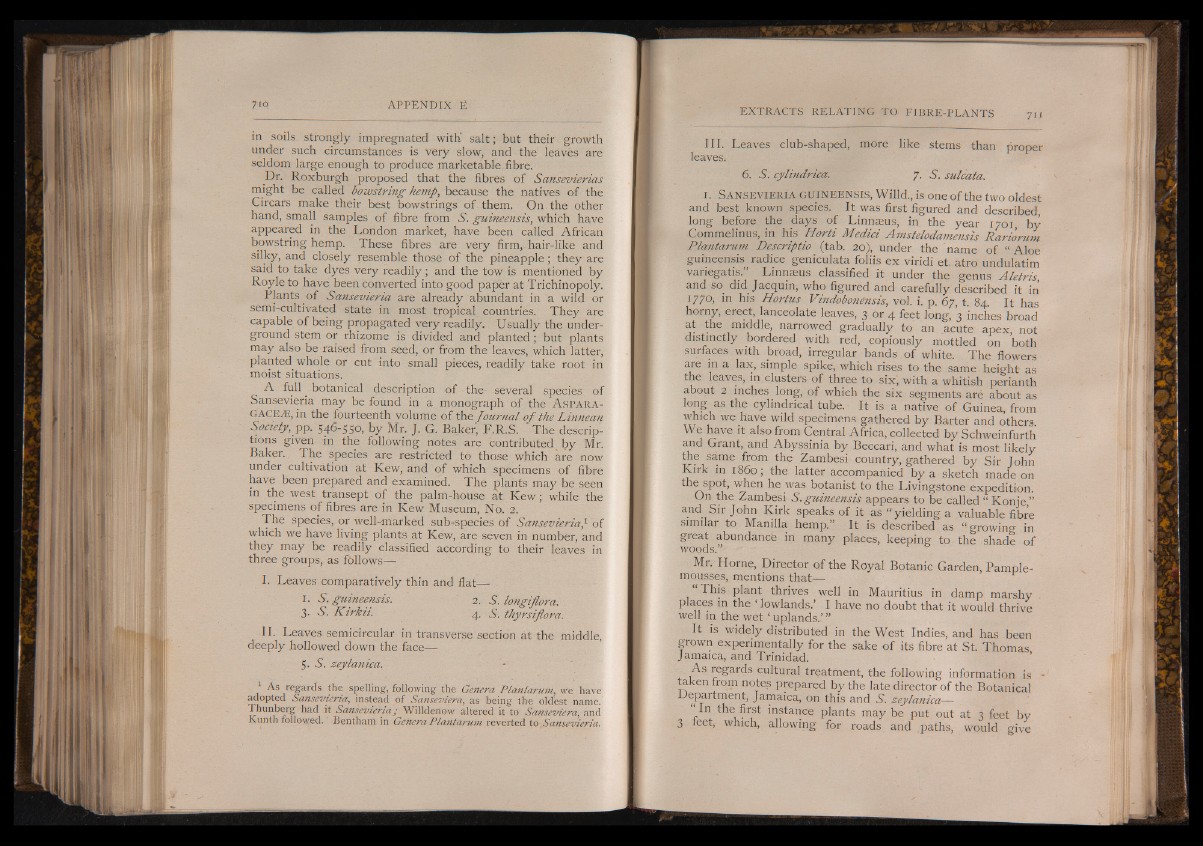
in soils strongly impregnated with' salt; but their growth
under such circumstances is very slow, and the leaves are
seldom large enough to produce marketable fibre.
Dr. Roxburgh proposed that the fibres of Sansevierias
might be called bowstring hemp, because the natives of the
Circars make their best bowstrings of them. On the other
hand, small samples of fibre from A. guineensis, which have
appeared in the London market, have been called African
bowstring hemp. These fibres are very firm, hair-like and
silky, and closely resemble those of the pineapple; they are
said to take dyes very readily; and the tow is mentioned by
Royle to have been converted into good paper at Trichinopoly.
Plants of Sansevieria are already abundant in a wild or
semi-cultivated state in most tropical countries. They are
capable of being propagated very readily. Usually the underground
stem or rhizome is divided and planted; but plants
may also be raised from seed, or from the leaves, which latter,
planted whole or cut into small pieces, readily take root in
moist situations.
A full botanical description of the several species of
Sansevieria may be found in a monograph of the A s p a r a -
GACE7E, in the fourteenth volume of the Journal o f the Linnean
Society, pp. 546-550, by Mr. J. G. Baker, F.R.S. The descrip'-
tions given in the following notes are "contributed by Mr.
Baker. The species are restricted to those which are now
under cultivation at Kew, and of which specimens of fibre
have been prepared and examined. The plants may be seen
in the west transept of the palm-house a!t Kew; while the
specimens of fibres are in Kew Museum, No. 2.
The species, or well-marked sub-species of Sansevieria/ of
which we have living plants at Kew, are seven in number, and
they may be readily classified according to their leaves in
three groups, as follows—
1 Leaves comparatively thin and flat— -
1. S- guineensis. 2. S. lohgiflora.
3. N. Ktrkii. 4. S. thyrsiflora.
II. Leaves semicircular in transverse section at the middle,
deeply hollowed down the face—
5. S. zeylanica. -
- As regards the spelling, following the Genera Plantarum, \vc . have
adopted Sansevieria, instead of Sanseviera, as being the oldest name.
Thunberg had it Sansevieria j Willdenow altered it to Sanseviera, and
Kunth followed. Bentham in Genera Plantarum reverted to Sansevieria.
III. Leaves club-shaped, more like stems than proper
leaves.
6. S. cylindrica. 7. S. sulcata.
1. S a n s e v i e r ia g u in e e n s i s , Willd., is one of the two oldest
and best known species. It was first figured and described
long before the days of Linnaeus, in the year 1701, by
Commelinus, in his Horti Medici Amstelodamensis Rariorum
Plantarum Descriptio (tab. 20), under the ’name of “ Aloe
guineensis radice geniculata foliis ex viridi et. atro undulatim
variegatis.” Linnaeus classified it under the genus Aletris
and so did Jacquin, who figured and carefully described it in
1770, in his Hortus Vindobonensis, vol. i. p. 67, t. 84. It has
horny, erect, lanceolate leaves, 3 or 4 feet long, 3 inches broad
. e i m ' narrowed gradually to an acute apex, not
distinctly bordered with red, copiously mottled on both
surfaces with broad, irregular bands of white. The flowers
are in a lax, simple spike, which rises to the same height as
the leaves, in clusters of three to six, with a whitish perianth
about 2 inches long, of which the six segments aré about as
long as the cylindrical tube. It is a native of Guinea, from
which we have wild specimens gathered by Barter and others
We have it also from Central Africa, collected by Schweínfurth
and Grant, and Abyssinia by Beccari, and what is most likely
the same from the Zambesi country, gathered by Sir John
Kirk in i860; the latter accompanied by a sketch made on
the spot, when he was botanist to the Livingstone expedition.
On the Zambesi S. guineensis appears to be called “ Konje,”
and Sir John Kirk speaks of it as “ yielding a valuable fibre
similar to Manilla hemp.” It is described as “ growing in
great abundancé in many places, keeping to the shade of
woods.”
Mr. Horne, Director of the Royal Botanic Garden, Pample-
mousses, mentions that—
“ This plant thrives well in Mauritius in damp marshy
places in the ‘ lowlands.’ I have no doubt that it would thrive
well in the wet ‘ uplands.! ”
It is widely distributed in the West Indies, and has been
grown experimentally for the sake of its fibre at St. Thomas
Jamaica, and Trinidad.
, As regards cultural treatment, the following information is *
taken from notes prepared by the late director of the Botanical
Department, Jamaica, on this and A. Zeylanica—
In the first instance plants may be put out at 3 feet by
3 teet, which, allowing for roads and paths, would give